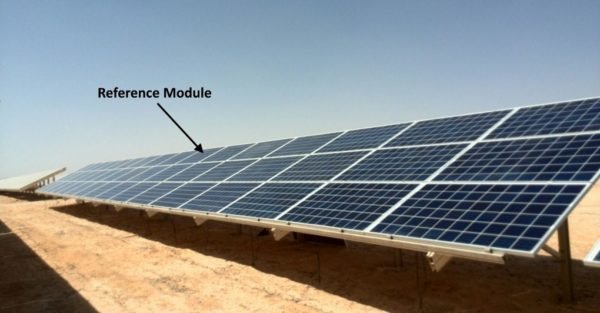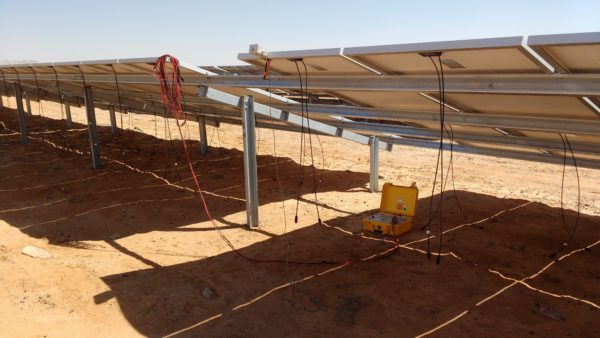The main component in utility-scale solar photovoltaic (PV) projects are the PV modules themselves. Typically, depending on the size and topology of the project, they can represent 30% to 40% of the initial investment.
To ensure a high return on investment (ROI), the implementation of suitable degradation control tests for modules is crucial to detect potential underperformance incidences on time, as well as to ensure the terms of warranty granted by the module supplier are being fulfilled throughout the entire lifecycle of the project, which is generally some 25-30 years.
Such degradation control tests are usually realized by measuring the Maximum Power of a representative sample of modules in standard test conditions (STC). Those measurements in STC are typically carried out in fixed laboratories, where irradiance, spectrum and temperature conditions are under control.
That means transporting modules from the plant to a suitable laboratory, which raises several issues, including: Risk of damage, due to the transportation/handling of the modules; production losses due to prolonged periods of disconnection; and customs issues surrounding the import/export of the modules, among others.
Against this background, the trend in the market to carry out such degradation control tests has been towards the implementation of Mobile Laboratories.
However, given the development of big PV projects in regions, such as Northern Africa (Morocco, Tunisia, Egypt), and the Middle East (Saudi Arabia, UAE, Jordan), where it is unusual to find fixed photovoltaic laboratories, and economically unviable to send mobile laboratories, we asked how degradation control tests could be carried out for these modules, in a precise, quick and economic manner.
The solution? Determine the Maximum Power of modules in STC through the correlation with reference modules.
Procedure to determinate maximum power of modules at standard test conditions in the field through correlation with measurements carried out in laboratory
For the measurement of modules in natural sunlight with a limited degree of uncertainty, Enertis has implemented a procedure, based on a methodology originally developed by the Institute of Solar Energy IES of the Universidad Politécnica de Madrid in Spain.
For the procedure, the calibration of a Reference Module (RM) is required, which, preferably, is manufactured with the same Bill of Material (BOM) as the modules to be measured – the Devices Under Test (DUT).

Reference Module installation (top) and portal measure equipment (bottom)

The RM should be carefully calibrated in an accredited laboratory with an expanded uncertainty measurement (k=2), preferably below 2%. Both the RM, as well as the DUT, must be measured on site quasi-simultaneously and in the same irradiance, spectrum and temperature conditions.
Given that the RM has the same spectral and thermal response as the DUT, a correlation between the corresponding measurements can be realized to determine the Laboratory Equal Maximum Power (LEMP) of the DUT.
This procedure does not require the removal of any modules, can be carried out easily, and makes use of portable measuring equipment. Indeed, it has been successfully implemented in utility-scale facilities located, for example, in Jordan, Chile, Italy and Spain.
And its simplicity has enabled measurement speeds of up to 100 modules per hour to be reached, with expanded measurement uncertainty levels always below ±3.5%.
Further technical details about the procedure can be found in the following scientific article: “Implementation of an accurate measurement procedure to determinate maximum power of modules at standard test conditions in the field through correlation with measurements carried out in laboratory”. Pérez, J.A. Florez, M. Martínez, E. Alvarez, F. Domínguez, G. Castillo, A. Inza, H. Silva, R. Gómez, M. Fernández, V. Parra and A. Velasco. 33rd European Photovoltaic Solar Energy Conference and Exhibition, Amsterdam 2017 pp. 1945-1949.
Leonardo Pérez is Technical and Operational Manager – Testing & Optimisation at Enertis, which he joined in 2011. He holds a Master Degree on Solar Energy from Université de Perpignan (France), and is a PhD Candidate at the Instituto de Energía Solar in Universidad Politécnica de Madrid.
The views and opinions expressed in this article are the author’s own, and do not necessarily reflect those held by pv magazine.
This content is protected by copyright and may not be reused. If you want to cooperate with us and would like to reuse some of our content, please contact: editors@pv-magazine.com.



By submitting this form you agree to pv magazine using your data for the purposes of publishing your comment.
Your personal data will only be disclosed or otherwise transmitted to third parties for the purposes of spam filtering or if this is necessary for technical maintenance of the website. Any other transfer to third parties will not take place unless this is justified on the basis of applicable data protection regulations or if pv magazine is legally obliged to do so.
You may revoke this consent at any time with effect for the future, in which case your personal data will be deleted immediately. Otherwise, your data will be deleted if pv magazine has processed your request or the purpose of data storage is fulfilled.
Further information on data privacy can be found in our Data Protection Policy.